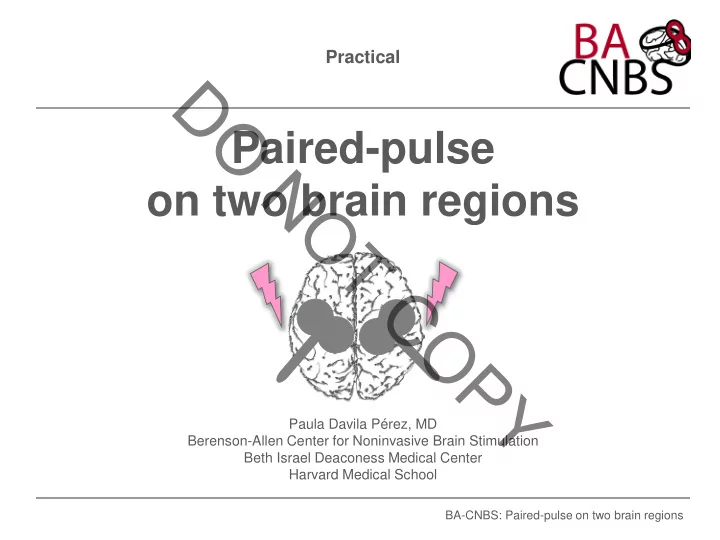

Practical D O Paired-pulse N on two brain regions O T C O P Y Paula Davila Pérez, MD Berenson-Allen Center for Noninvasive Brain Stimulation Beth Israel Deaconess Medical Center Harvard Medical School BA-CNBS: Paired-pulse on two brain regions
Plans for the afternoon D O N • Introduce ourselves O T • Physiological and technical aspects C O • Practice TMS! P Y • Clinical aspects and applications BA-CNBS: Paired-pulse on two brain regions
Basic concepts D O • Paired-pulse protocols N • Intracortical • Intrahemisheric O • Interhemispheric • Different brain structures T C • Paired-pulse in two brain regions O ISI • Test pulse ( TP ) MEP on target muscle #1 #2 P CP TP Y • Conditioning pulse ( CP ) • Inter stimulus interval ( ISI ) (ms) BA-CNBS: Paired-pulse on two brain regions
Physiological aspects: Transcallosal inhibition, but also… D O N INHIBITION: ISI 6-30ms Transcallosal inhibition (IHI) O • To avoid mirror movement, allow unilateral movement, and hemispheric T specialization C • To allow exchange of unilaterally represented information O P Y But also FACILITATION at ISI 3-5 ms (inconsistent): • To allow transfer of information via the CC between the two hemispheres? BA-CNBS: Paired-pulse on two brain regions
Physiological aspects: D O Corpus callosum: - 200 million fibers N - largest white matter structure O - GABA B interneurons T #2 #1 TP CP C Transcallosal pathway: short latency studies in total or partial callostomy O ± direct ipsilateral pathway (?) P Y IHI has intracortical origin TES vs TMS (Ferbert et al. 1992) I waves (Di Lazzaro et al. 1999) BA-CNBS: Paired-pulse on two brain regions
Different parameters… D O N IHI dependent on: • Intensity of CS ( ↑ duration), TS ( ↑ depth) and increasing ISI ( ↑ 5-15 ms) O T • State of target muscle ( → control for muscle contraction!) - Contraction of muscle contralateral to the CS ↑ IHI C - Effect disappears if the muscle contralateral to TS is also activated O P And… Y • Hand dominance (studies are contradicting) • Gender differences (IHI women > men; ISI range well circumscribed in women) BA-CNBS: Paired-pulse on two brain regions
Test pulse alone (RH) Footswitch D O MEP N Output B Amplifiers Trigger O Output A Timer T Master: A C Input Slave: B O Output Input P Y
Conditioning pulse (LH) & D Test pulse (RH) Footswitch O MEP N Output B O Amplifiers Trigger Output A Timer T Master: A C Input Slave: B O Output Input P Y
Procedure to measure IHI D O • 2 to measure RH baseline (TS alone) (120% • 1 right-handed subject N of RMT, with the two coils) • 2 to prepare the electrodes over the O • 2 to apply the paired pulses from L->R two hands T • 1-2 to prepare the cap and the marking CP on LH and TS on RH (120 % of RMT) on the two hemispheres ISI of 8-12 ms (12 ms women, 10 ms men) C • 2 to find RMT on LH and RH O P Always monitor the relaxation of the muscle! Y IHI = 100*(PP MEP - TS alone MEP)/(TS alone MEP) We expect a decrease of 20 to 40% but it may not work today! BA-CNBS: Paired-pulse on two brain regions
How to find FDI hotspot with a standard Magstim figure-of-eight coil D O N O • Monophasic coil 5 cm T • Handle pointed backwards 45º C 5 cm Vertex • Current directed posterior-anterior M1 O • Perpendicular to central sulcus P Y Safe coil and machine handling! BA-CNBS: Paired-pulse on two brain regions
What are we going to do? D O • Mapping both M1 to find hotspot to determine RMT (FDI) N O • Baseline (TP alone, monophasic coil) at 120% of RMT T • Paired-pulse: Conditioning pulse (CP) followed by test pulse (TP) (on C optimal MEP site) ISI O - TP at 120% of RMT #1 #2 - CP at 120% of RMT P CP TP - ISI = 8 - 12 ms Y • What do we get? BA-CNBS: Paired-pulse on two brain regions
From a historical point of view D O • Various contradictory studies about callosotomies (“split-brain”) N O • Ferbert et al., 1992: first description T • Vuilleumier et al., 1996: right parietal stroke followed by a left frontal C stroke O • Geschwind & Kaplan, 1962: “deconnection syndrome” due to P callosal lesions Y BA-CNBS: Paired-pulse on two brain regions
Clinical aspects How could we use it? D O • PD ( ↓ )? Mirror movements? Dystonia? Cortical myoclonus ( ↓ )? N • MS: prolonged transcallosal conduction time O T • Stroke - IHI ↓ from affected to unaffected side (balance model) C O - IHI ↑ before movement onset (from unaffected to affected side) P Y • Assess the efficiency of brain stimulation and/or rehabilitation? • Deconnection syndrome? Assess integrity of CC? (Chen et al., 2008) BA-CNBS: Paired-pulse on two brain regions
Outside M1… Be aware of network effects! D O • Cerebellum - M1: Suppression of MEPs at ISIs of 5-8 ms (Ugawa et al., N 1995) O T • FEF and extrastriate visual cortex (MT/V5): stimulation of FEF 20-40 ms prior to stimulation of MT/V5 decreases the intensity needed to evoke a C phosphene (Silvanto et al., 2006) O P • PPC and contralateral M1: stimulation of right caudal IPS facilitates MEPs Y but stimulation of anterior IPS suppresses them. Directly or via homologous areas (Koch et al., 2009) BA-CNBS: Paired-pulse on two brain regions
Recommend
More recommend